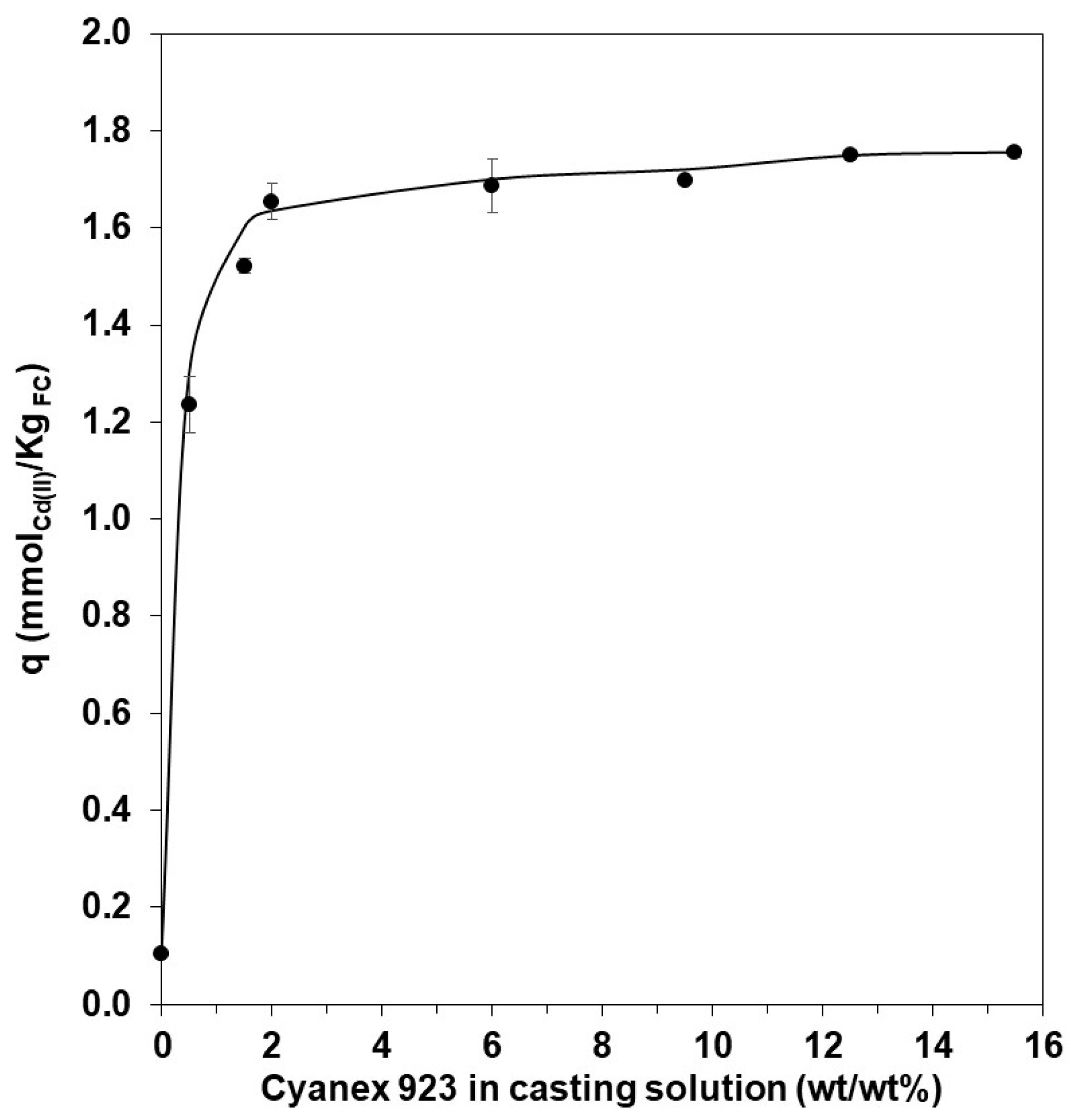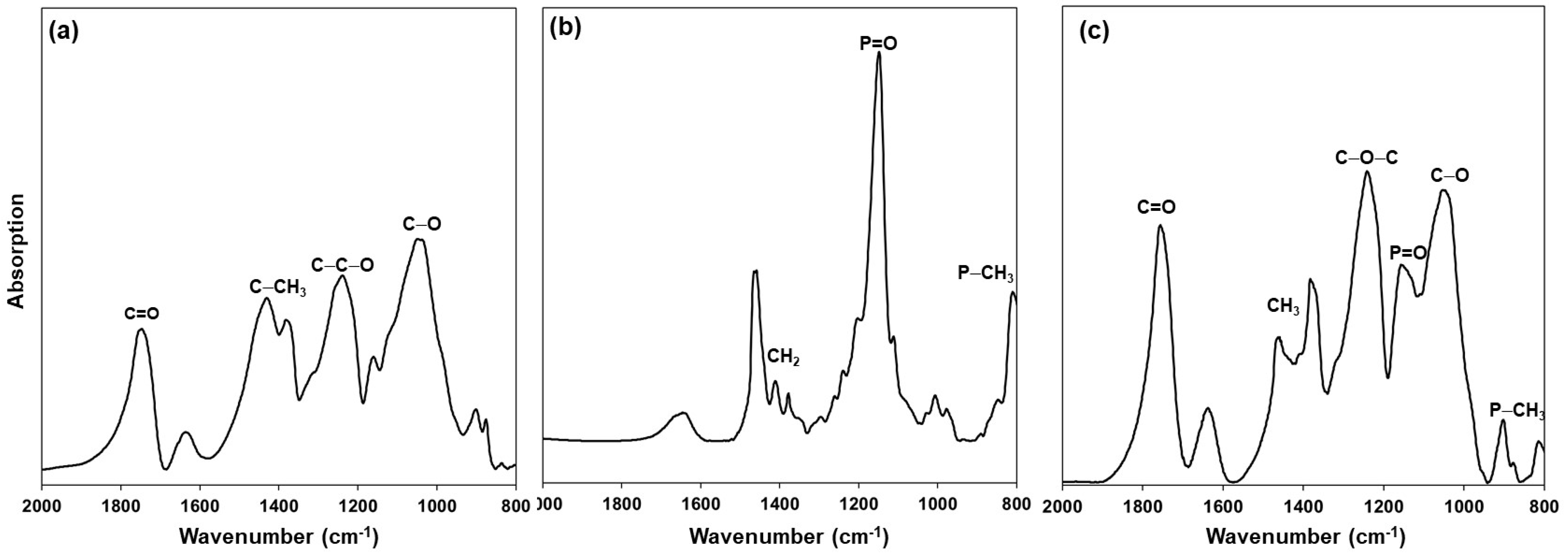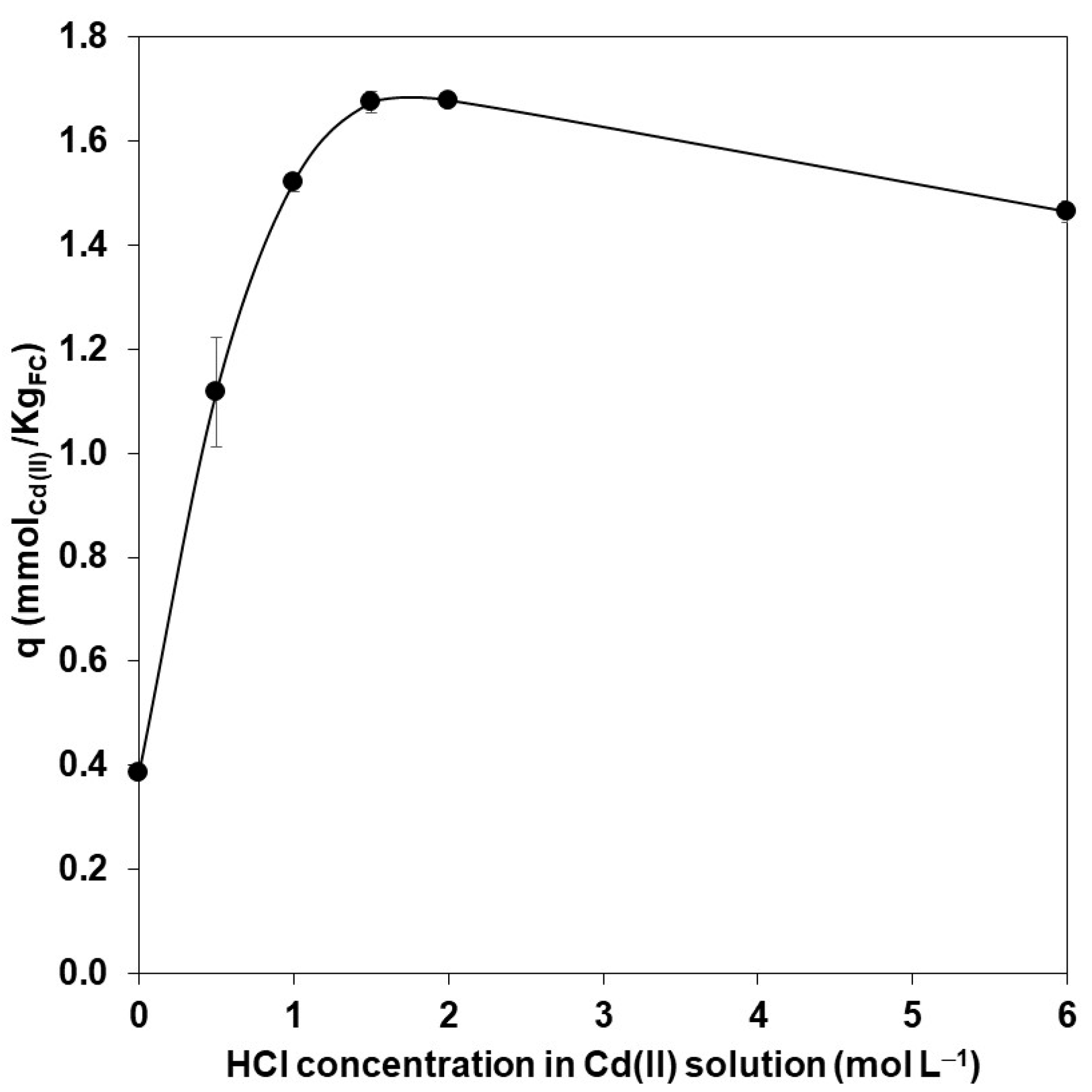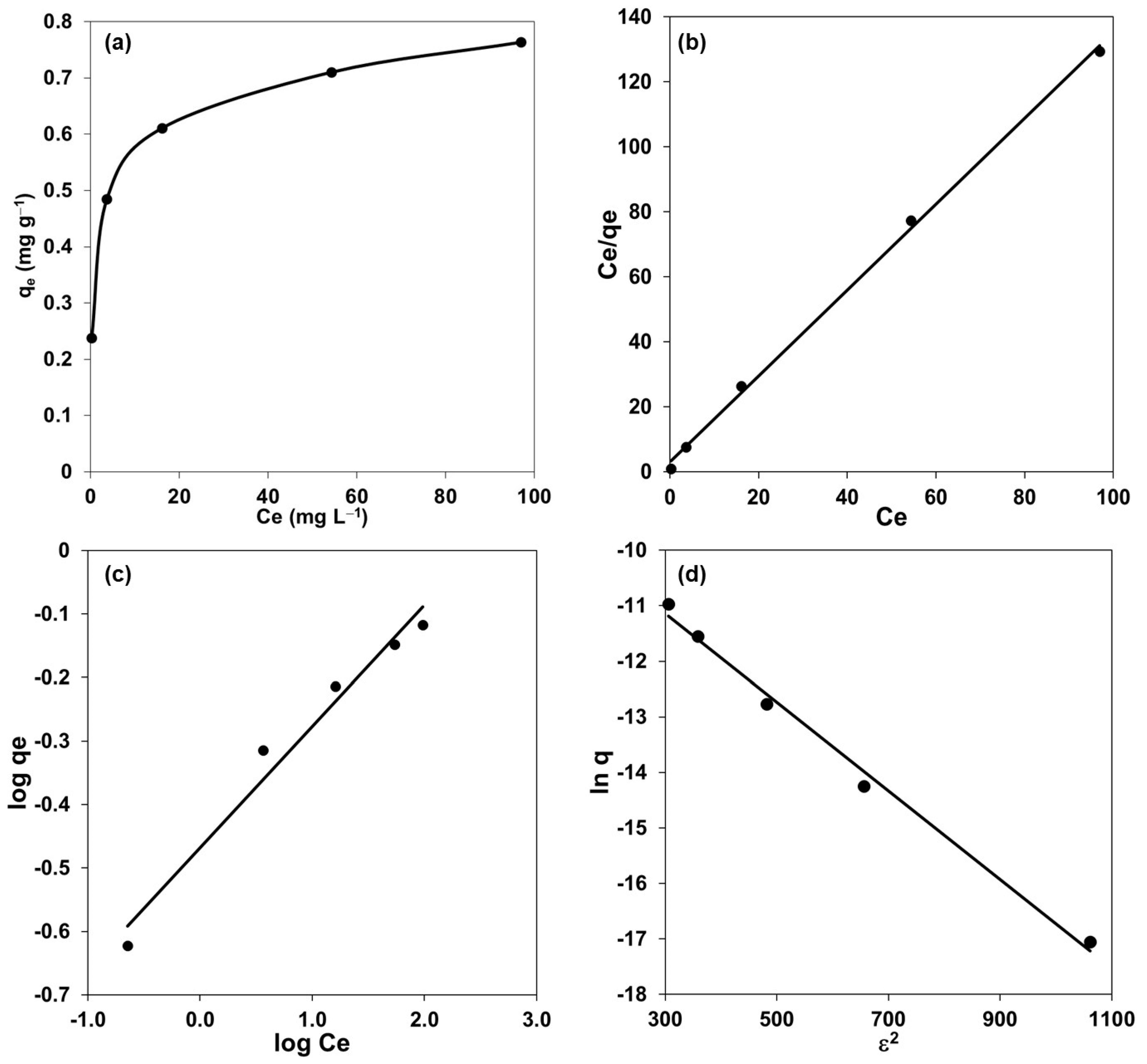The Evaluation of Cellulose Acetate Capsules Functionalized for the Removal of Cd(II)
Abstract
:1. Introduction
2. Materials and Methods
2.1. Materials
2.2. Preparation of Functionalized Capsules (FC)
2.3. Cd(II) Extraction and Recovery Experiments
2.4. Battery-Leaching Process
3. Results
3.1. Evaluation of the Amount of Extractant
3.2. Variation of the Number of Capsules Used during Extraction Experiments
3.3. Evaluation of the Effect of Chlorhydric Medium on Cadmium Extraction
3.4. Extraction Isotherms
3.5. Kinetic Studies
3.6. FC Reusability Study
3.7. Recovery of Cd(II) from a Real Sample
4. Conclusions
Author Contributions
Funding
Institutional Review Board Statement
Informed Consent Statement
Data Availability Statement
Acknowledgments
Conflicts of Interest
References
- Liu, K.; Du, H.; Zheng, T.; Liu, H.; Zhang, M.; Zhang, R.; Li, H.; Xie, H.; Zhang, X.; Ma, M.; et al. Recent advances in cellulose and its derivatives for oilfield applications. Carbohydr. Polym. 2021, 259, 117740. [Google Scholar] [CrossRef]
- Heinze, T.; El Seoud, O.A.; Koschella, A. Production and Characteristics of Cellulose from Different Sources. In Cellulose Derivatives; Springer Series on Polymer and Composite Materials; Springer: Cham, Switzerland, 2018; pp. 1–38. [Google Scholar]
- Oprea, M.; Voicu, S.I. Recent advances in composites based on cellulose derivatives for biomedical applications. Carbohyd. Polym. 2020, 247, 116383. [Google Scholar] [CrossRef]
- Kaur, G.; Grewal, J.; Jyoty, K.; Jain, U.K.; Chandra, R.; Madan, J. Oral controlled and sustained drug delivery systems: Concepts, advances, preclinical, and clinical status. In Drug Targeting and Stimuli Sensitive Drug Delivery Systems; Grumezescu, A.M., Ed.; William Andrew Publishing: Norwich, NY, USA, 2018; pp. 567–626. [Google Scholar]
- Rai, P.K.; Choure, K. Agriculture waste to bioplastics: A perfect substitution of plastics. In Value-Addition in Agri-Food Industry Waste Through Enzyme Technology; Kuddus, M., Ramteke, P., Eds.; Academic Press: Cambridge, MA, USA, 2023; pp. 299–314. [Google Scholar]
- Wu, J.H.; He, C.Y. Advances in Cellulose-Based Sorbents for Extraction of Pollutants in Environmental Samples. Chromatographia 2019, 82, 1151–1169. [Google Scholar] [CrossRef]
- Eltaweil, A.S.; Abd El-Monaem, E.M.; El-Subruiti, G.M.; Ali, B.M.; Abd El-Latif, M.M.; Omer, A.M. Graphene oxide incorporated cellulose acetate beads for efficient removal of methylene blue dye; isotherms, kinetic, mechanism and co-existing ions studies. J. Porous Mater. 2023, 30, 607–618. [Google Scholar] [CrossRef]
- Basha, I.K.; Abd El-Monaem, E.M.; Khalifa, R.E.; Omer, A.M.; Eltaweil, A.S. Sulfonated graphene oxide impregnated cellulose acetate floated beads for adsorption of methylene blue dye: Optimization using response surface methodology. Sci. Rep. 2022, 12, 9339. [Google Scholar] [CrossRef] [PubMed]
- Gopi, S.; Pius, A.; Kargl, R.; Kleinscheck, K.S.; Thomas, S. Fabrication of cellulose acetate/chitosan blend films as efficient adsorbent for anionic water pollutants. Polym. Bull. 2019, 76, 1557–1571. [Google Scholar] [CrossRef]
- Putri, K.N.A.; Keereerak, A.; Chinpa, W. Novel cellulose-based biosorbent from lemongrass leaf combined with cellulose acetate for adsorption of crystal violet. Int. J. Biol. Macromol. 2020, 156, 762–772. [Google Scholar] [CrossRef] [PubMed]
- Torkashvand, J.; Saeedi-Jurkuyeh, A.; Kalantary, R.R.; Gholami, M.; Esrafili, A.; Yousefi, M.; Farzadkia, M. Preparation of a cellulose acetate membrane using cigarette butt recycling and investigation of its efficiency in removing heavy metals from aqueous solution. Sci. Rep. 2022, 12, 20336. [Google Scholar] [CrossRef] [PubMed]
- Figoli, A.; Ursino, C.; Santoro, S.; Ounifi, I.; Chekir, J.; Hafiane, A.; Ferjani, E. Cellulose Acetate Nanofiltration Membranes for Cadmium Remediation. J. Membr. Sci. Res. 2020, 6, 226–234. [Google Scholar]
- Hamad, A.A.; Hassouna, M.S.; Shalaby, T.I.; Elkady, M.F.; Abd Elkawi, M.A.; Hamad, H.A. Electrospun cellulose acetate nanofiber incorporated with hydroxyapatite for removal of heavy metals. Int. J. Biol. Macromol. 2020, 151, 1299–1313. [Google Scholar] [CrossRef]
- Zargar, B.; Parham, H.; Shiralipour, R. Removal of Pb and Cd ions from contaminated water by dithizone-modified cellulose acetate nanosponges. JMES 2017, 8, 1039–1045. [Google Scholar]
- Omer, A.M.; Elgarhy, G.S.; El-Subruiti, G.M.; Abd El-Monaem, E.M.; Eltaweil, A.S. Construction of efficient Ni-FeLDH@MWCNT@Cellulose acetate floatable microbeads for Cr(VI) removal: Performance and mechanism. Carbohydr. Polym. 2023, 311, 120771. [Google Scholar] [CrossRef] [PubMed]
- Genchi, G.; Sinicropi, M.S.; Lauria, G.; Carocci, A.; Catalano, A. The effects of cadmium toxicity. Int. J. Environ. Res. Public Health 2020, 17, 3782. [Google Scholar] [CrossRef]
- U.S. Environmental Protection Agency. Priority Pollutant List: 2015 (Appendix A to Part 423—126 Priority Pollutants). Available online: https://www.ecfr.gov/current/title-40/chapter-I/subchapter-N/part-423/appendix-Appendix%20A%20to%20Part%20423 (accessed on 7 July 2023).
- World Health Organization. Exposure to Cadmium: A Major Public Health Concern: 2019. Available online: https://www.who.int/publications/i/item/WHO-CED-PHE-EPE-19-4-3 (accessed on 7 July 2023).
- Bernardes, A.M.; Espinosa, D.C.R.; Tenório, J.A.S. Recycling of batteries: A review of current processes and technologies. J. Power Sources 2004, 130, 291–298. [Google Scholar] [CrossRef]
- Assefi, M.; Maroufi, S.; Yamauchi, Y.; Sahajwalla, V. Pyrometallurgical recycling of Li-ion, Ni–Cd and Ni–MH batteries: A minireview. Curr. Opin. Green Sustain. Chem. 2020, 24, 26–31. [Google Scholar] [CrossRef]
- Blumbergs, E.; Serga, V.; Platacis, E.; Maiorov, M.; Shishkin, A. Cadmium Recovery from Spent Ni-Cd Batteries: A Brief Review. Metals 2021, 11, 1714. [Google Scholar] [CrossRef]
- Muñoz, S.V.; Martínez, M.S.; Torres, M.G.; Alcalá, S.P.; Quintanilla, F.; Rodríguez-Canto, A.; Rodríguez, J.R. Adsorption and Removal of Cadmium Ions from Simulated Wastewater Using Commercial Hydrophilic and Hydrophobic Silica Nanoparticles: A Comparison with Sol–gel Particles. Water Air Soil Pollut. 2014, 225, 2165. [Google Scholar] [CrossRef]
- Ianăşi, C.; Picioruş, M.; Nicola, R.; Ciopec, M.; Negrea, A.; Nižňanský, D.; Len, A.; Almásy, L.; Putz, A.-M. Removal of cadmium from aqueous solutions using inorganic porous nanocomposites. Korean J. Chem. Eng. 2019, 36, 688–700. [Google Scholar] [CrossRef]
- Kaur, J.; Sengupta, P.; Mukhopadhyay, S. Critical Review of Bioadsorption on Modified Cellulose and Removal of Divalent Heavy Metals (Cd, Pb, and Cu). Ind. Eng. Chem. Res. 2022, 61, 1921–1954. [Google Scholar] [CrossRef]
- Sjahro, N.; Yunus, R.; Abdullah, L.C.; Rashid, S.A.; Asis, A.J.; Akhlisah, Z.N. Recent advances in the application of cellulose derivatives for removal of contaminants from aquatic environments. Cellulose 2021, 28, 7521–7557. [Google Scholar] [CrossRef]
- Zheng, L.; Yang, Y.; Meng, P.; Peng, D. Absorption of cadmium (II) via sulfur-chelating based cellulose: Characterization, isotherm models and their error analysis. Carbohydr. Polym. 2019, 209, 38–50. [Google Scholar] [CrossRef]
- Fakhre, N.A.; Ibrahim, B.M. The use of new chemically modified cellulose for heavy metal ion adsorption. J. Hazard. Mater. 2018, 343, 324–331. [Google Scholar] [CrossRef]
- Aziz, T.; Farid, A.; Haq, F.; Kiran, M.; Ullah, A.; Zhang, K.; Li, C.; Ghazanfar, S.; Sun, H.; Ullah, R.; et al. A Review on the Modification of Cellulose and Its Applications. Polymers. 2022, 14, 3206. [Google Scholar] [CrossRef] [PubMed]
- Leopold, A.A.; Coll, M.T.; Fortuny, A.; Rathore, N.S.; Sastre, A.M. Mathematical modeling of cadmium(II) solvent extraction from neutral and acidic chloride media using Cyanex 923 extractant as a metal carrier. J. Hazard. Mater. 2010, 182, 903–911. [Google Scholar] [CrossRef] [PubMed]
- Gong, X.C.; Luo, G.S.; Yang, W.W.; Wu, F.Y. Separation of organic acids by newly developed polysulfone microcapsules containing trioctylamine. Sep. Purif. Technol. 2006, 48, 235–243. [Google Scholar] [CrossRef]
- Yang, W.W.; Luo, G.S.; Wu, F.Y.; Chen, F.; Gong, X.C. Di-2-ethylhexyl phosphoric acid immobilization with polysulfone microcapsules. React. Funct. Polym. 2004, 61, 91–99. [Google Scholar] [CrossRef]
- Gonçalves Lacerda, V.; Barbosa Mageste, A.; Boggione Santos, I.J.; Mendes da Silva, L.H.; Hespanhol da Silva, M.C. Separation of Cd and Ni from Ni–Cd batteries by an environmentally safe methodology employing aqueous two-phase systems. J. Power Sources 2009, 193, 908–913. [Google Scholar] [CrossRef]
- Chen, B.; Bao, S.; Zhang, Y.; Zheng, R. A high-efficiency approach for the synthesis of N235-impregnated resins and the application in enhanced adsorption and separation of vanadium (V). Minerals 2018, 8, 358. [Google Scholar] [CrossRef]
- Sajjan, P.; Nayak, V.; Padaki, M.; Zadorozhnyy, V.Y.; Klyamkin, S.N.; Konik, P. Fabrication of Cellulose acetate film by blending technique with palladium acetate for Hydrogen gas separation. Energy Fuels 2020, 34, 11699–11707. [Google Scholar] [CrossRef]
- Tulos, N.; Harbottle, D.; Hebden, A.; Goswami, P.; Blackburn, R.S. Kinetic Analysis of Cellulose Acetate/Cellulose II Hybrid Fiber Formation by Alkaline Hydrolysis. ACS Omega 2019, 4, 4936–4942. [Google Scholar] [CrossRef]
- Nguyen, T.T.N.; Lee, M.S. Application of the data on dielectric constant and viscosity of binary mixtures to the selection of synergistic solvent extraction-binary mixtures of Cyanex and tertiary amine (TEHA). J. Mol. Liq. 2019, 289, 111112. [Google Scholar] [CrossRef]
- Noweir, H.G.; Masry, B.A.; Zeid, M.M.; Kassem, A.T.; Daoud, J.A. Sorption of Mo (VI) From Nitric Acid Solution Using SM-4 Copolymer Resin Impregnated with CYANEX 923. J. Inorg. Organomet. Polym. Mater. 2021, 31, 1576–1589. [Google Scholar] [CrossRef]
- Van Nguyen, N.; Lee, J.C.; Jeong, J.; Pandey, B.D. Enhancing the adsorption of chromium(VI) from the acidic chloride media using solvent impregnated resin (SIR). Chem. Eng. J. 2013, 219, 174–182. [Google Scholar] [CrossRef]
- Martínez, S.; Sastre, A.; Miralles, N.; Alguacil, F.J. Gold (III) extraction equilibrium in the system Cyanex 923-HCl-Au (III). Hydrometallurgy 1996, 40, 77–88. [Google Scholar] [CrossRef]
- Puigdomenech, I. MEDUSA Program: 2016. KTH Royal Institute of Technology in Stockholm. Available online: https://www.kth.se/che/medusa/downloads-1.386254 (accessed on 18 June 2023).
- Ali, I.; Peng, C.; Naz, I.; Lin, D.; Saroj, D.P.; Ali, M. Development and application of novel bio-magnetic membrane capsules for the removal of the cationic dye malachite green in wastewater treatment. RSC Adv. 2019, 9, 3625–3646. [Google Scholar] [CrossRef]
- Liu, D.; Yuan, J.; Li, J.; Zhang, G. Preparation of chitosan poly(methacrylate) composites for adsorption of bromocresol green. ACS Omega 2019, 4, 12680–12686. [Google Scholar] [CrossRef]
- Faisal, M.; Kana, S.; Muslim, A.; Gani, A.; Nabila, H. Adsorption of Cd(II) in a semi-continuous process by residual charcoal from the pyrolyzed oil palm shells. RJC 2022, 15, 1792–1798. [Google Scholar] [CrossRef]
- Bezzina, J.P.; Robshaw, T.; Dawson, R.; Ogden, M.D. Single metal isotherm study of the ion exchange removal of Cu(II), Fe(II), Pb(II) and Zn(II) from synthetic acetic acid leachate. Chem. Eng. J. 2020, 394, 124862. [Google Scholar] [CrossRef]
- Hinojosa Reyes, L.; Saucedo Medina, I.; Navarro Mendoza, R.; Revilla Vázquez, J.; Avila Rodríguez, M.; Guibal, E. Extraction of cadmium from phosphoric acid using resins impregnated with organophosphorus extractants. Ind. Eng. Chem. Res. 2001, 40, 1422–1433. [Google Scholar] [CrossRef]
- Arias, A.; Saucedo, I.; Navarro, R.; Gallardo, V.; Martinez, M.; Guibal, E. Cadmium (II) recovery from hydrochloric acid solutions using Amberlite XAD-7 impregnated with a tetraalkyl phosphonium ionic liquid. React. Funct. Polym. 2011, 71, 1059–1070. [Google Scholar] [CrossRef]
- Benamor, M.; Bouariche, Z.; Belaid, T.; Draa, M.T. Kinetic studies on cadmium ions by Amberlite XAD7 impregnated resins containing di(2-ethylhexyl) phosphoric acid as extractant. Sep. Purif. Technol. 2008, 59, 74–84. [Google Scholar] [CrossRef]
- Navarro, R.; Saucedo, I.; Núñez, A.; Ávila, M.; Guibal, E. Cadmium extraction from hydrochloric acid solutions using Amberlite XAD-7 impregnated with Cyanex 921 (tri-octyl phosphine oxide). React. Funct. Polym. 2008, 68, 557–571. [Google Scholar] [CrossRef]
- Alba, J.; Navarro, R.; Saucedo, I.; Vincent, T.; Guibal, E. Cadmium recovery from HCl solutions using Cyanex 301 and Cyanex 302 immobilized in alginate capsules (matrix-type vs. mononuclear-type mode of encapsulation). Solvent Extr. Ion Exch. 2017, 35, 345–362. [Google Scholar] [CrossRef]
- Wang, Y.; Jing, Y.; Hou, H.; Xu, J.; Wang, Y. Extraction of lanthanides by polysulfone microcapsules containing EHPNA. II. Coaxial microfluidic method. J. Rare Earths 2015, 33, 765–775. [Google Scholar] [CrossRef]
- Sartape, A.S.; Mandhare, A.M.; Salvi, P.P.; Pawar, D.K.; Kolekar, S.S. Kinetic and equilibrium studies of the adsorption of Cd(II) from aqueous solutions by wood apple shell activated carbon. Desalination Water Treat. 2013, 51, 4638–4650. [Google Scholar] [CrossRef]
- Chen, T.; Liu, H.; Gao, J.; Hu, G.; Zhao, Y.; Tang, X.; Han, X. Efficient Removal of Methylene Blue by Bio-Based Sodium Alginate/Lignin Composite Hydrogel Beads. Polymers 2022, 14, 2917. [Google Scholar] [CrossRef] [PubMed]
- Guo, X.; Wang, J. A general kinetic model for adsorption: Theoretical analysis and modeling. J. Mol. Liq. 2019, 288, 111100. [Google Scholar] [CrossRef]
- Ozcan, S.; Tor, A.; Aydin, M.E. Removal of Cr(VI) from aqueous solution by polysulfone microcapsules containing Cyanex 923 as extraction reagent. Desalination 2010, 259, 179–186. [Google Scholar] [CrossRef]








| Cyanex 923 in Casting Solution (wt/vol%) | Phosphorous Atomic Percentage (%) |
|---|---|
| 0.00 | 0.00 |
| 0.50 | 0.08 |
| 1.50 | 0.11 |
| 2.00 | 0.19 |
| 6.00 | 1.75 |
| 9.50 | 2.24 |
| 12.50 | 2.42 |
| 15.50 | 2.67 |
| FC Mass (g) | Cadmium Extraction in Percentage 2 (%) |
|---|---|
| 0.05 | 18.63 (3.56) |
| 0.20 | 59.10 (3.84) |
| 0.30 | 79.07 (1.19) |
| 0.40 | 79.51 (6.13) |
| 0.50 | 85.50 (1.18) |
| 1.00 | 96.49 (0.03) |
| Contact Time (h) | Cadmium Extraction in Percentage 2 (%) |
|---|---|
| 0.25 | 59.58 (2.10) |
| 0.50 | 76.41 (2.83) |
| 1.00 | 81.76 (3.94) |
| 2.00 | 97.46 (0.67) |
| 5.00 | 98.15 (0.17) |
| 7.00 | 98.23 (0.68) |
| Model | Estimated Isotherm Parameters 1 | |
|---|---|---|
| Langmuir | Qo (mg g−1) | 0.77 |
| KL (L mg−1) | 0.52 | |
| R2 | 0.998 | |
| Freundlich | KF (L g−1) | 0.34 |
| no | 5.24 | |
| R2 | 0.972 | |
| Dubinin Radushkevich | β (mol2 J−2) | 0.008 |
| ε (KJ mol−1) | 7.91 | |
| R2 | 0.993 | |
| Qo Cd(II) (mgCd(II) g−1) | qextractant 4 (mgextractant/gmaterial) | Extractant | Reference |
|---|---|---|---|
| 1.56 | 77 (XAD2) 1 | Cyanex 301 | [46] |
| 11.5 | 138 (XAD7)1 | Cyanex 301 | |
| 4.89 | 99 | Cyphos® IL-101 2 | [47] |
| 36.57 | 416 | Cyphos® IL-101 2 | |
| 13.54 | 271 | DEHPA 3 | [48] |
| 41.06 | 500 | DEHPA 3 | |
| 13.1 | 366 | Cyanex 921 | [49] |
| 17.5 | 528 | Cyanex 921 | |
| 15–42 | 94–290 | Cyanex 301 | [50] |
| 14–34 | 204–481 | Cyanex 302 |
| Model | Estimated Kinetic Parameters 1 | |
|---|---|---|
| Pseudo-first-order | qe (mg g−1) | 6.203 |
| K1 (min−1) | −4.40 × 10−5 | |
| R2 | 0.943 | |
| Pseudo-second-order | qe (mg g−1) | 20.20 |
| K2 (g mg−1 min−1) | 0.005 | |
| R2 | 0.999 | |
Disclaimer/Publisher’s Note: The statements, opinions and data contained in all publications are solely those of the individual author(s) and contributor(s) and not of MDPI and/or the editor(s). MDPI and/or the editor(s) disclaim responsibility for any injury to people or property resulting from any ideas, methods, instructions or products referred to in the content. |
© 2023 by the authors. Licensee MDPI, Basel, Switzerland. This article is an open access article distributed under the terms and conditions of the Creative Commons Attribution (CC BY) license (https://creativecommons.org/licenses/by/4.0/).
Share and Cite
Pérez-Silva, I.; Canales-Feliciano, G.D.; Rodríguez, J.A.; Mendoza-Huizar, L.H.; Pérez-Estrada, S.; Ibarra, I.S.; Páez-Hernández, M.E. The Evaluation of Cellulose Acetate Capsules Functionalized for the Removal of Cd(II). Polymers 2023, 15, 3917. https://doi.org/10.3390/polym15193917
Pérez-Silva I, Canales-Feliciano GD, Rodríguez JA, Mendoza-Huizar LH, Pérez-Estrada S, Ibarra IS, Páez-Hernández ME. The Evaluation of Cellulose Acetate Capsules Functionalized for the Removal of Cd(II). Polymers. 2023; 15(19):3917. https://doi.org/10.3390/polym15193917
Chicago/Turabian StylePérez-Silva, Irma, Gladis D. Canales-Feliciano, José A. Rodríguez, Luis H. Mendoza-Huizar, Salvador Pérez-Estrada, Israel S. Ibarra, and M. Elena Páez-Hernández. 2023. "The Evaluation of Cellulose Acetate Capsules Functionalized for the Removal of Cd(II)" Polymers 15, no. 19: 3917. https://doi.org/10.3390/polym15193917
APA StylePérez-Silva, I., Canales-Feliciano, G. D., Rodríguez, J. A., Mendoza-Huizar, L. H., Pérez-Estrada, S., Ibarra, I. S., & Páez-Hernández, M. E. (2023). The Evaluation of Cellulose Acetate Capsules Functionalized for the Removal of Cd(II). Polymers, 15(19), 3917. https://doi.org/10.3390/polym15193917









